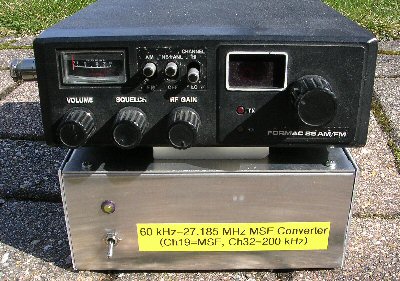Old CB radios may not make a very compact set-up but they are easy to open-up and modify (no surface mount components) and they usually have plenty of space inside to add circuits (the converter for example). In addition you can easily wire into the receivers AGC S-meter circuitry to use it as a detector for example.
I had an old Formac 88 from my radio repair days at GWM Radio and so decided to use this. I have found it gives good stability and excellent sensitivity. I changed the 10.7 MHz ceramic IF filter in the CB for a crystal filter. This improved selectivity but at some cost to sensitivity. I am not sure if this was really necessary for MSF but the mod may come in handy when monitoring other VLF signals etc (e.g. with the tuneable VLF ferrite rod antenna described last time).
The simple converter
The converter design is based around the NE602 double balanced mixer [1]. The 60 kHz signal from the antenna passes through a pre-amp and filter stage into the mixer where it is combined with the LO produced by the 602's internal oscillator (and an external xtal). The product goes to a simple output filter to feed the receiver. I used an aluminium metal box for the converter and used coax inputs and outputs. The converter will run from 9 to 15 V.
Input stage
The input stage provides some gain and good filtering. It uses a FET and a couple of pot-core inductors (L) to form a narrow band pass filter. You need ca. 4000 to 5000 pf to get the inductors to resonate at 60 kHz. If possible use fixed tuned caps to get the tuning within the range and then use the ferrite cores to tune for maximum signal.
Note: I have found that the tolerance specification on inductors to be quite unreliable. When I was at the NPL I spent hours trying to get apparent copies of this circuit to tune to 60 kHz. If you can, get hold of a capacitance box to switch through till you hit resonance. At a particular setting the preamp will burst into life – it's a nice moment!
The two 220pf capacitors around the tuned circuits will have quite a large reactance at 60 kHz; ca. 100k ohm. If these are increased, to say 1nf, it might give better sensitivity for less selectivity which may make the filter less sensitive to temperature changes etc.
Mixer Calculations
The mixer takes the 60 kHz signal (0.06 MHz) passed on by the i/p stage and combines it with 27.125 MHz to convert the MSF signal to 27.125 + 0.06 = 27.185 MHz (or alternatively 27.125 – 0.06 = 27.065 MHz). The old AM CB radios used 27.125 MHz as channel 14. With 10 kHz spacing this should mean that MSF should appear 6 channels up on channel 20. However for some reason 27.145 MHz was not allocated to the AM CB service and this channel was skipped making 27.185 MHz channel 19 [2]. 27.125 MHz (third overtone) xtals are one of the old standard radio control frequencies so are easy to find (e-bay etc but remember to use the 'Tx' not the 'Rx' of the pair). I have a bag of 50 or so 27.125 MHz xtals (good old GWM) so if any of the club would like one (free) do let me know.
The mixer requires an inductor (L3) to get the xtal to resonate and for 27 MHz this was about 16-18 turns of enamelled copper wire on a 6mm diameter former. I used a screening can. Of course you can use another completely different band / frequency as long as you chose the correct crystal, and modify the crystal oscillator inductor and o/p stage accordingly.

Setting up
It's a tall order to expect the simple balanced mixer not to pass the 27.125 MHz LO through to the CB receiver and so the signal on CH14 is indeed very strong (it does allow an easy check that the LO is working though). This may well effect the performance of the MSF reception up on CH19, but as the MSF signal throughout the UK is very reliable, and we are not looking for a DX weak signal, there is no real problem using this simple converter for receiving the MSF data.
The output of the mixer drives a tuned circuit L4 (18 turns 35 SWG on 6mm former, 2 turn coupling coil and a screening can) which should of course be peaked for maximum response. I used a few turns of wire around the main windings as a coupling to the receiver but found the drive was a little high for the CB and so also used a 3.3 pf capacitor in series to the CB radio. BBC radio 4 on 198 kHz is a very strong LF signal and should be converted to ca. 27.125 + 0.200 = 27.325 MHz which will be on CH32 or CH33. However the input filtering must be quite good as nothing can be heard, at least not when using a ferrite rod antenna (which also provides good band pass).
I am currently using the set-up with the 8 ferrite rod antenna (described last time) for long term monitoring of the MSF signal strength over the ca. 500 km path from the transmitter (Anthorn, Northern England) into Sussex (Worthing). I have wired into the CB's AGC S-meter circuit and fed this to a buffer and 10 second time constant integrator (to try and remove as much of the 1 pps changes due to the time code data). There is an interesting signal strength drop just before dawn that I want to investigate further.
Next time we discuss various detection techniques used to get reliable data from the MSF CW signal.
References and Links
[1] NE602 data sheet
THE CREATIVE SCIENCE CENTRE
home | diary | whats on | CSC summary | latest news